The Human Head Skull Role as Our First Thermoregulatory Natural Shield to Excessive Electromagnetic Fields at 1800 MHz
Abstract
:1. Introduction
2. Materials and Methods
3. Simulated Results and Discussion
4. Conclusions
Author Contributions
Funding
Data Availability Statement
Acknowledgments
Conflicts of Interest
References
- International Commission on Non-Ionizing Radiation Protection (ICNIRP) Guidelines. Guidelines for limiting exposure to time-varying electric, magnetic, and electromagnetic fields (up to 300 GHz). Health Phys. 1998, 74, 494–522. [Google Scholar]
- American Conference of Government Industrial Hygienists (ACGIH). Threshold Limit Values (TLVs) for Chemical Substances and Physical Agents and Biological Exposure Indices (BEIs); American Conference of Governmental Industrial Hygienists (ACGIH): Cincinnati, OH, USA, 1996. [Google Scholar]
- Adair, E.R.; Adams, B.W.; Akel, G.M. Minimal changes in hypothalamic temperature accompany microwave-induced alteration of thermoregulatory behavior. Bioelectromagnetics 1984, 5, 13–30. [Google Scholar] [CrossRef] [PubMed]
- IEC 62209-1; Human Exposure to Radio Frequency Fields from Hand-Held and Body-Mounted Wireless Communication Devices—Human Models, Instrumentation, and Procedures—Part 1: Procedure to Determine the Specific Absorption Rate (SAR) for Hand-Held Devices Used in Close Proximity to the Ear (Frequency Range of 300 MHz to 3 GHz). International Electrotechnical Commission: Geneva, Switzerland, 2005.
- Bortkiewicz, A.; Gadzicka, E.; Szymczak, W.; Zmyślony, M. Changes in tympanic temperature during the exposure to electromagnetic fields emitted by mobile phone. Int. J. Occup. Med. Environ. Health 2012, 25, 145–150. [Google Scholar] [CrossRef] [PubMed]
- Kodera, S.; Hirata, A.; Funahashi, D.; Watanabe, S.; Jokela Kand Croft, R.J. Temperature rise for brief radio-frequency exposure below 6 GHz. IEEE Access 2018, 6, 65737–65746. [Google Scholar] [CrossRef]
- Adair, E.R.; Black, D.R. Thermoregulatory Responses to RF Energy Absorption. Bioelectromagnetics 2003, 6, 17–38. [Google Scholar] [CrossRef] [PubMed]
- Bernardi, P.; Cavagnaro, M.; Pisa, S.; Piuzzi, E. SAR Distribution and Temperature Increase in an Anatomical Model of the Human Eye Exposed to the Field Radiated by the User Antenna in a Wireless LAN. IEEE Trans. Microw. Theory Tech. 1998, 46, 1118–1126. [Google Scholar] [CrossRef]
- Kodera, S.; Gomez-Tames, J.; Hirata, A. Temperature elevation in the human brain and skin with thermoregulation during exposure to RF energy. Biomed. Eng. 2018, 17, 1. [Google Scholar] [CrossRef] [PubMed]
- Bhargava, D.; Leeprechanon, N.; Rattanadecho, P.; Wessapanet, T. Specific absorption rate and temperature elevation in the human head due to overexposure to mobile phone radiation with different usage pattern. Int. J. Heat Mass Transf. 2019, 130, 1178–1188. [Google Scholar] [CrossRef]
- Hirata, A.; Kodera, S.; Sasaki, K.; Gomez-Tames, J.; Laakso, I.; Wood, A.; Watanabe, S.; Foster, K.R. Human exposure to radiofrequency energy above 6 GHz: Review of computational dosimetry studies. Phys. Med. Biol. 2021, 66, 08TR01. [Google Scholar] [CrossRef] [PubMed]
- Mason, P.A.; Hurt, W.D.; Walters, T.J.; D’Andrea, J.A.; Gajšek, P.; Ryan, K.L.; Nelson, D.A.; Smith, K.I.; Ziriax, J.M. Recent advances in dosimetry measurements and modeling. In Radio Frequency Radiation Dosimetry; Klauenberg, B.J., Miklavčič, D., Eds.; Springer: Dordrecht, The Netherlands, 2000; pp. 141–155. [Google Scholar]
- Ghandi, O.P.; Lazzi, G.; Furse, C.M. Electromagnetic absorption in the human head and neck for mobile telephones at 835 and 1900 MHz. IEEE Trans. Microw. Theory Tech. 1996, 44, 1865–1873. [Google Scholar]
- CENELEC EN50383; Basic Standard for the Calculation and Measurement of Electromagnetic Field Strength and SAR Related to Human Exposure from Radio Base Stations and Fixed Terminal Stations for Wireless Telecommunication Systems (110 MHz–40 GHz). European Committee for Electrotechnical Standardization: Brussels, Belgium, 2002.
- Joseph, W.; Martens, L. Safety factor for determination of occupational electromagnetic exposure in phantom model. Electron. Lett. 2003, 39, 1663–1664. [Google Scholar] [CrossRef]
- Christ, A.; Klingenbock, A.; Samaras, T.; Goiceanu, C.; Kuster, N. The dependence of electromagnetic far-field absorption on body tissue composition in the frequency range from 300 MHz to 6 GHz. IEEE Trans. Microw. Theory Tech. 2006, 54, 2188–2195. [Google Scholar] [CrossRef]
- 3GPP TS 45.005 V17.0.0 (2022-03); Technical Specification 3rd Generation Partnership Project; Technical Specification Group Radio Access Network; GSM/EDGE Radio Transmission and Reception (Release 17). 2022.
- 3GPP TR 25.889 V6.0.0 (2003-06); Technical Report 3rd Generation Partnership Project; Technical Specification Group Radio Access Network; Feasibility Study Considering the Viable Deployment of UTRA in Additional and Diverse Spectrum Arrangements. 2003.
- 3GPP TS 36.10 V18.4.0 (2024-01); Evolved Universal Terrestrial Radio Access (E-UTRA); User Equipment (UE) Radio Transmission and Reception. 2024.
- 3GPP TS 38.101-1 V18.4.0 (2023-12); Technical Specification 3rd Generation Partnership Project; Technical Specification Group Radio Access Network; NR; User Equipment (UE) Radio Transmission and Reception; Part 1: Range 1 Standalone (Release 18). 2023.
- Gabriel, C. Compilation of the Dielectric Properties of Body Tissues at RF and Microwave Frequencies; Brooks Air Force Tech. Rep.; AL/OE-TR-1996-003.7; 1996.
- Ackerman, M.J. The Visible Human Project. Proc. IEEE 1998, 86, 504–511. [Google Scholar] [CrossRef]
- Pennes, H.H. Analysis of tissue and arterial blood temperature in the resting human forearm. J. Appl. Physiol. 1948, 1, 93–122. [Google Scholar] [CrossRef] [PubMed]
- Durney, C.H.; Massoudi, H.; Iskander, M.F. Radiofrequency Radiation Dosimetry Handbook, 4th ed.; Brooks Air Force Base; TX 78235-5301 Tech. Rep. USAFSAM-TR-85-73; 1996.
- Adair, E.R.; Kelleher, S.A.; Mack, G.W.; Morocco, T.S. Thermophysiological responses of human volunteers during controlled whole-body ratio frequency exposure at 450 MHz. Bioelectromagnetics 1998, 19, 232–245. [Google Scholar] [CrossRef]
- Cueille, M.; Makhlouf, O.; Dubard, J.-L. TLM computation of temperature distribution in human head exposed to electromagnetic waves. In Proceedings of the IEEE International Symposium on Antennas and Propagation (APSURSI), Fajardo, PR, USA, 26 June–1 July 2016. [Google Scholar]
- Joubert, V.; Leveque, P.; Cueille, M.; Bourthoumieu, S.; Yardin, C. No apoptosis is induced in rat cortical neurons exposed to GSM phone fields. Bioelectromagnetics 2006, 28, 115–121. [Google Scholar] [CrossRef] [PubMed]
- Cueille, M.; Makhlouf, O.; Dubard, J.-L. A new TLM algorithm to solve the Pennes’s equation for dosimetry applications. In Proceedings of the European Microwave Conference (EuMC), Paris, France, 7–10 September 2015. [Google Scholar]
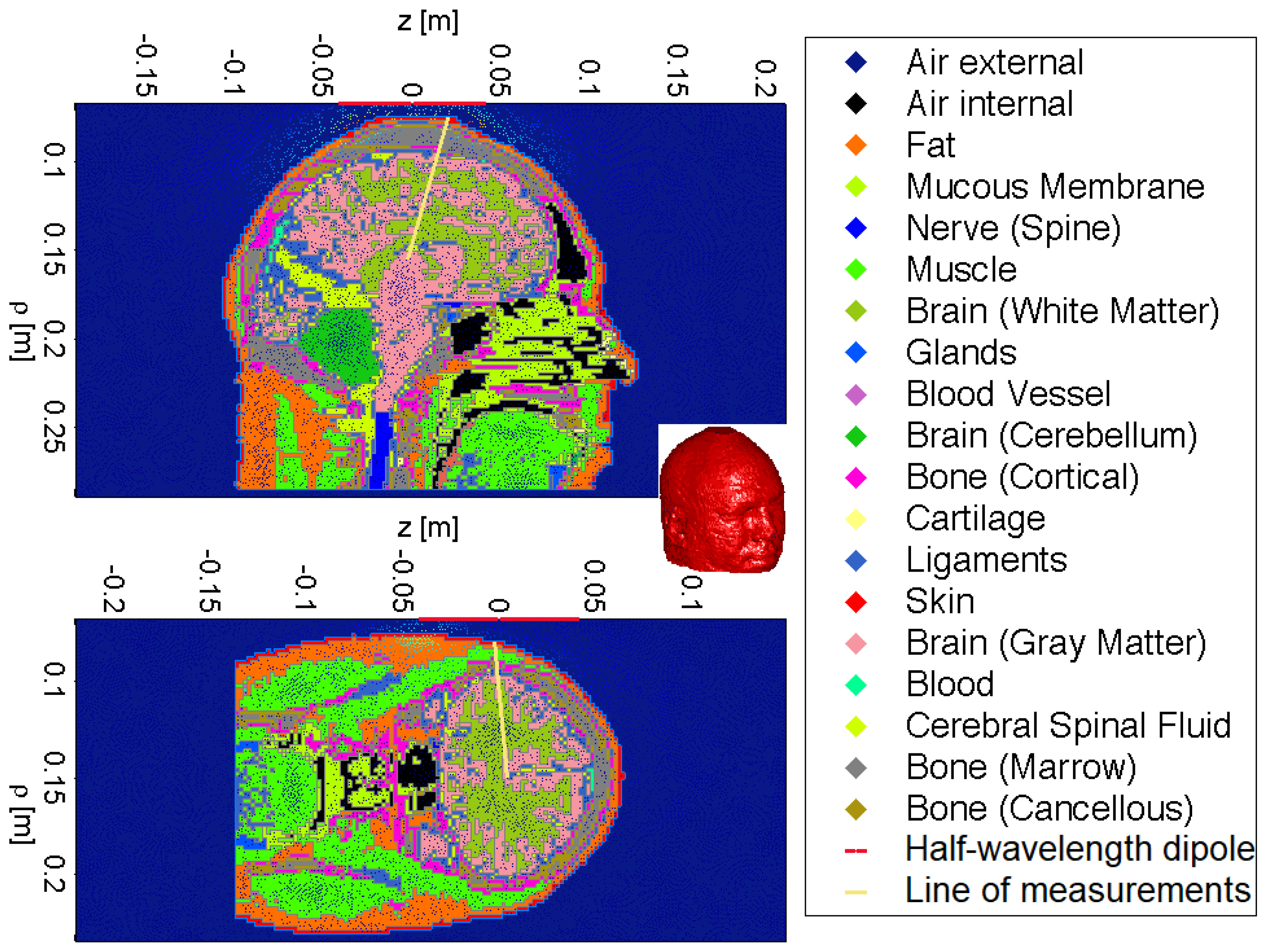
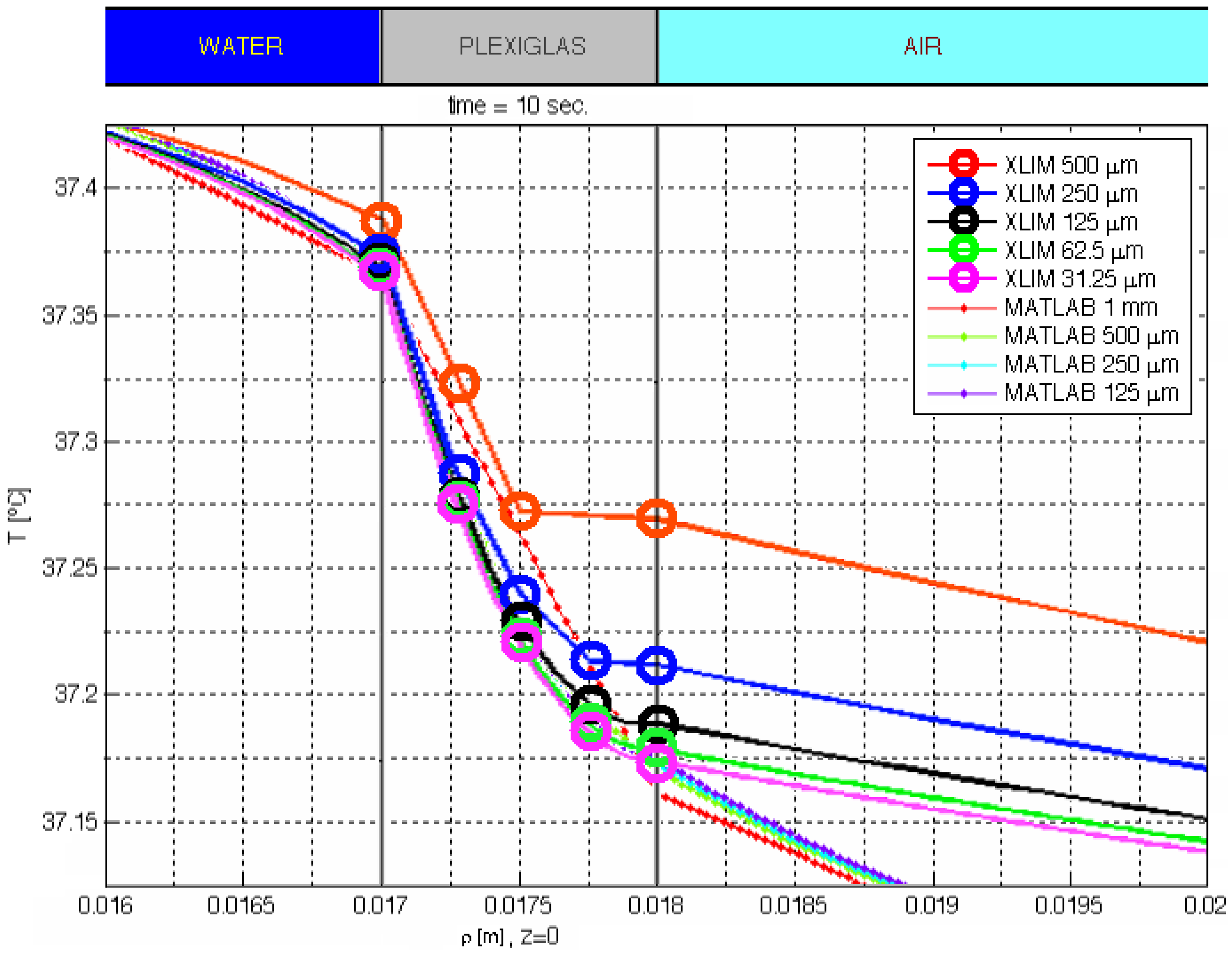

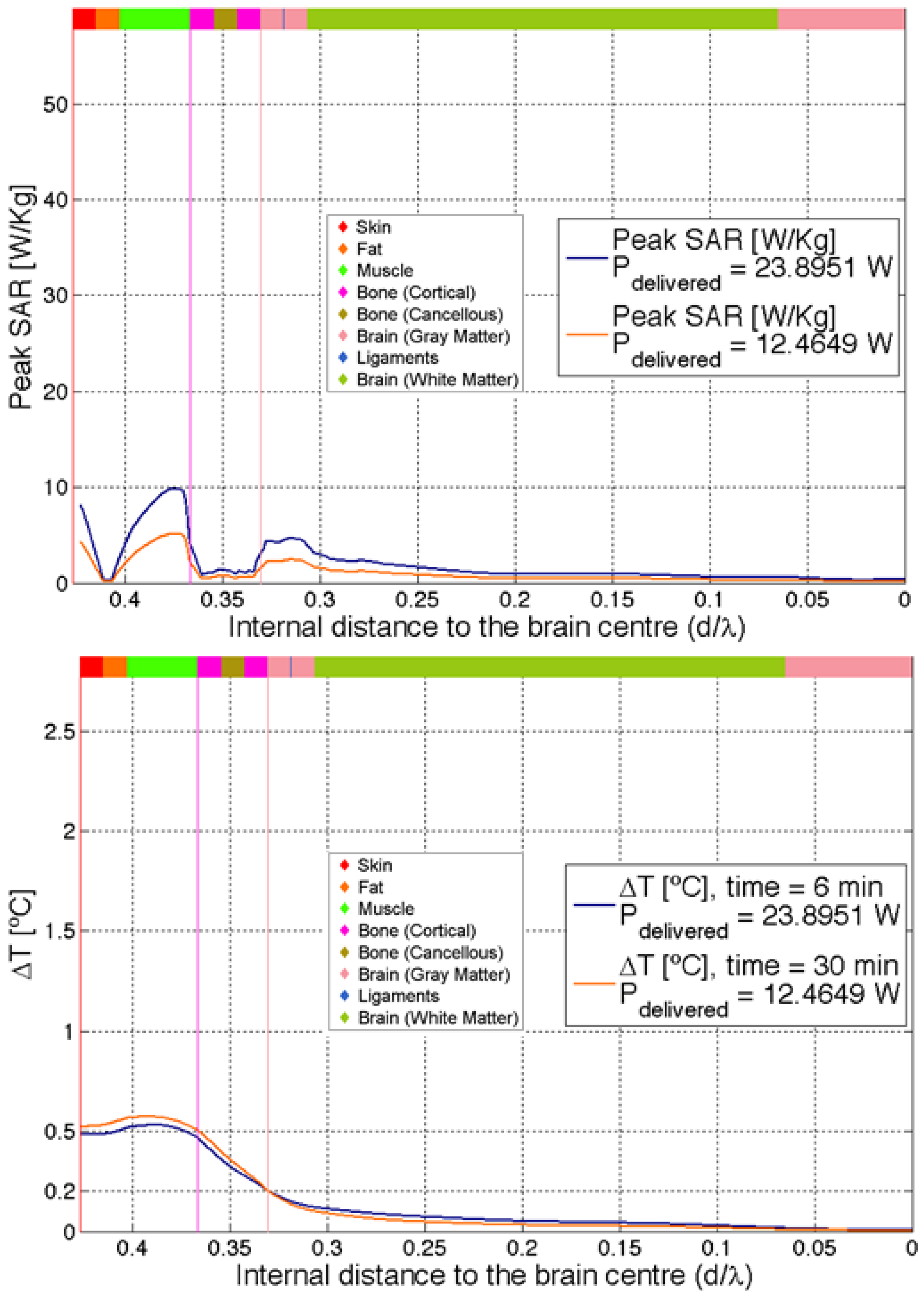

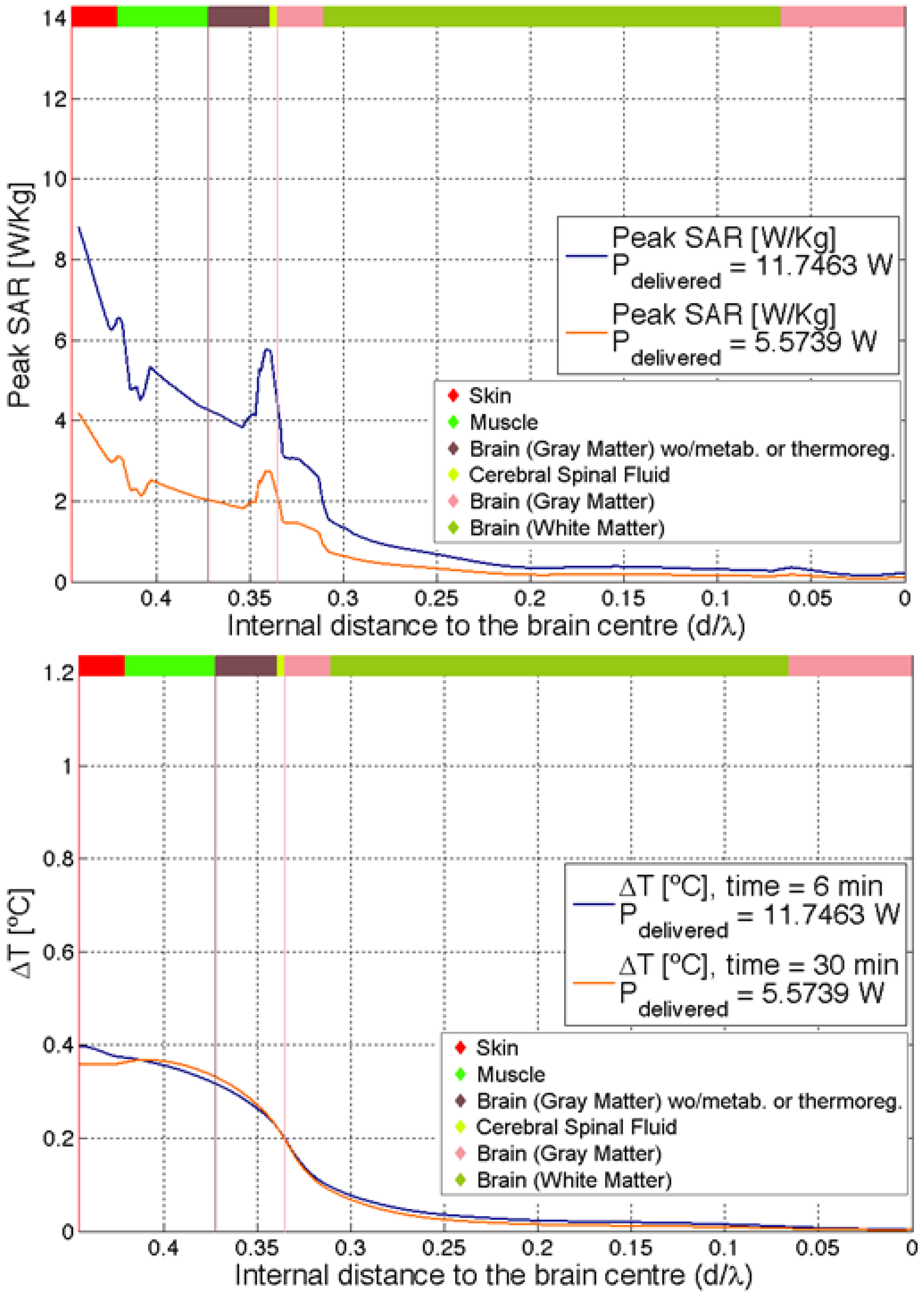
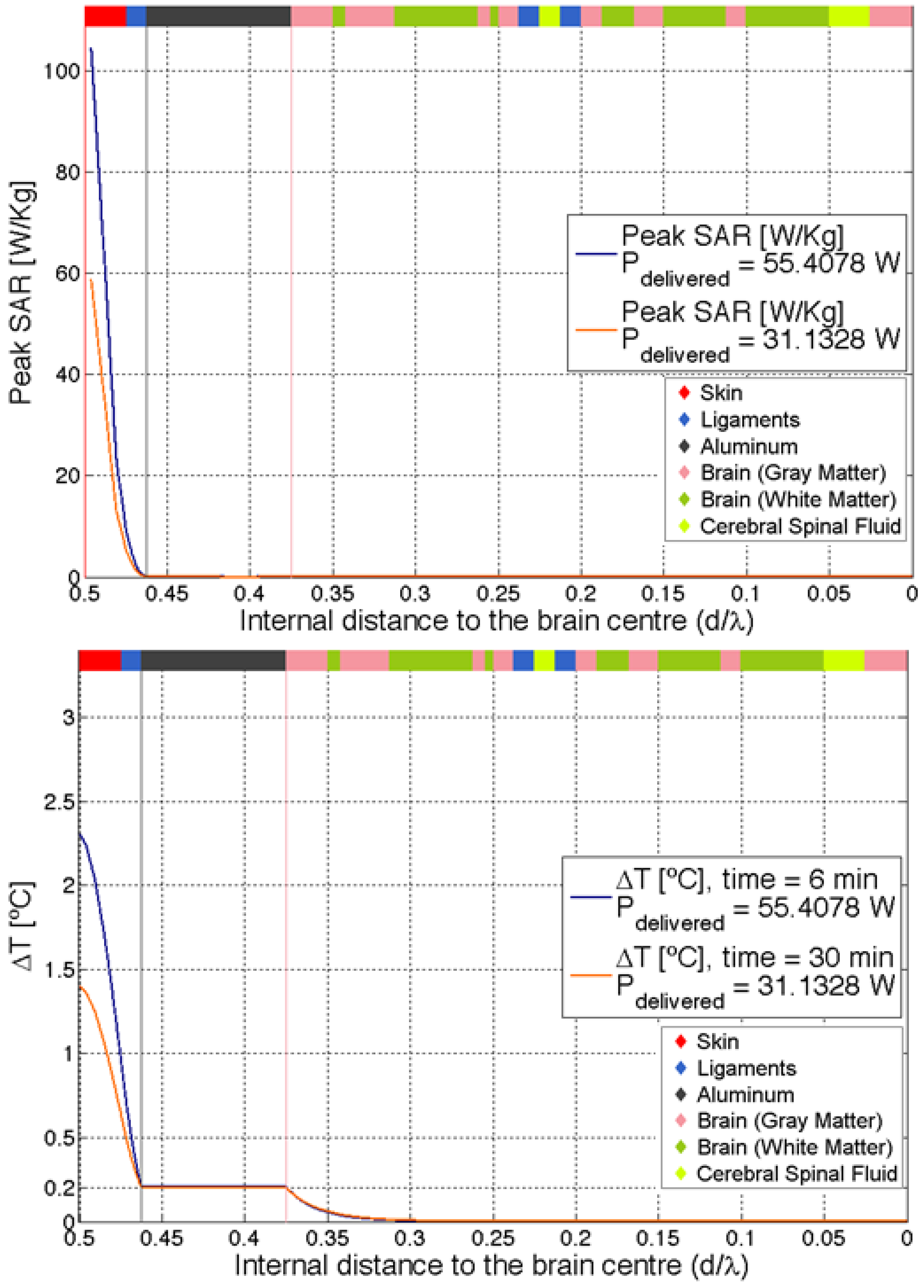
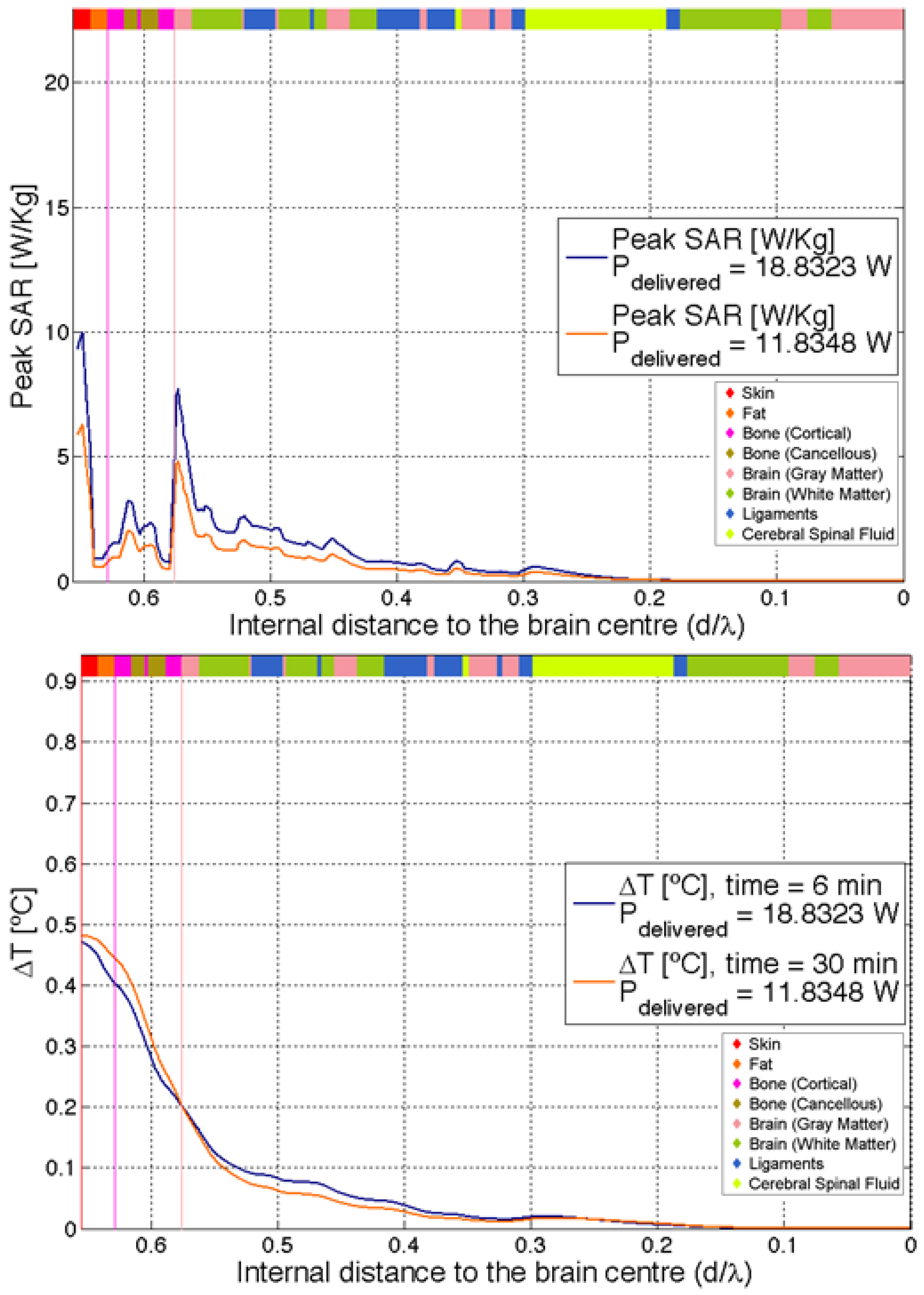
| Tissue | εr | σ (S/m) | ρ Density (kg/m3) | C Specific Heat Capacity (J/kg·°C) | K Thermal Conductivity (W/m·°C) | A Metabolic Heat Production (W/m3) | B Blood Flow Associated Term (W/m3·°C) |
|---|---|---|---|---|---|---|---|
| Blood | 59.37 | 2.044 | 1058 | 3840 | 0.49 | 0 | 0 |
| Blood Vessel | 43.34 | 1.066 | 1040 | 3553 | 0.46 | 1600 | 9000 |
| Bone (Cancellous) | 19.34 | 0.588 | 1920 | 2150 | 0.30 | 2510 | 14,120 |
| Bone (Cortical) | 11.78 | 0.275 | 1990 | 1650 | 0.30 | 0 | 0 |
| Bone (Marrow) | 5.37 | 0.069 | 1040 | 2700 | 0.22 | 5020 | 28,230 |
| Brain (Cerebellum) | 46.11 | 1.709 | 1038 | 3687 | 0.57 | 10,040 | 56,490 |
| Brain (Gray Matter) | 50.08 | 1.391 | 1038 | 3687 | 0.57 | 10,040 | 56,490 |
| Brain (White Matter) | 37.01 | 0.915 | 1038 | 3600 | 0.50 | 2820 | 15,890 |
| Skin | 38.87 | 1.845 | 1125 | 3610 | 0.42 | 2190 | 12,310 |
Disclaimer/Publisher’s Note: The statements, opinions and data contained in all publications are solely those of the individual author(s) and contributor(s) and not of MDPI and/or the editor(s). MDPI and/or the editor(s) disclaim responsibility for any injury to people or property resulting from any ideas, methods, instructions or products referred to in the content. |
© 2024 by the authors. Licensee MDPI, Basel, Switzerland. This article is an open access article distributed under the terms and conditions of the Creative Commons Attribution (CC BY) license (https://creativecommons.org/licenses/by/4.0/).
Share and Cite
García-Fernández, M.Á.; Sánchez-Hernández, D.A. The Human Head Skull Role as Our First Thermoregulatory Natural Shield to Excessive Electromagnetic Fields at 1800 MHz. Electronics 2024, 13, 1475. https://doi.org/10.3390/electronics13081475
García-Fernández MÁ, Sánchez-Hernández DA. The Human Head Skull Role as Our First Thermoregulatory Natural Shield to Excessive Electromagnetic Fields at 1800 MHz. Electronics. 2024; 13(8):1475. https://doi.org/10.3390/electronics13081475
Chicago/Turabian StyleGarcía-Fernández, Miguel Á., and David A. Sánchez-Hernández. 2024. "The Human Head Skull Role as Our First Thermoregulatory Natural Shield to Excessive Electromagnetic Fields at 1800 MHz" Electronics 13, no. 8: 1475. https://doi.org/10.3390/electronics13081475
APA StyleGarcía-Fernández, M. Á., & Sánchez-Hernández, D. A. (2024). The Human Head Skull Role as Our First Thermoregulatory Natural Shield to Excessive Electromagnetic Fields at 1800 MHz. Electronics, 13(8), 1475. https://doi.org/10.3390/electronics13081475







